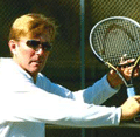Teaching with the Eye Coach
Scott Murphy
"Watch the ball!" How many times have you heard that or said it to yourself while playing tennis? What does that really mean, anyway, watch the ball?
When players "sort of" watch the ball, they’ll do it up until a few feet before contact. Then they move the head to see where their shot is going before they’ve even struck the shot.
The problem of course is that when your head moves prematurely your eyes and your body will as well. That’s human nature—to be overly concerned about the outcome of our shots.
Moving your head too soon doesn’t mean of course that you’ll miss all your shots but it adds uncertainty to the outcome. So how to deal with this problem for the long run?
I first came across the Eye Coach a few years ago and instantly loved it. It represents a powerful new way to address the use of the eyes and the position of the head. I have one at home and one at my teaching court and use them both on a daily basis. A large number of my students have also acquired an Eye Coach and love it.
Roger
When Roger Federer burst on the scene everyone marveled how he kept his head still during and after contact. I’m convinced it’s an integral part of his genius.
Apparently it was something he developed on his own did and was kidded about it as a junior. Now of course every high performance coach in the world is advocating it as if they discovered it themselves.
For years I would lay this out for my students and get great results--for a while anyway. The beauty of the Eye Coach is you can work on creating and maintaining this head position and really reinforce the learning experience--without dealing with the issue of outcome anxiety on every ball.
After you work with the Eye Coach you can’t help but notice how it positively affects your timing and your contact point when you go back to rallying and playing. By keeping your head still and eyes focused on the ball you’ll begin to achieve solid, early contact much more often.
The benefits go way beyond technical. In his wonderful article on Tennisplayer, Damien LaFont shows that what he calls "gaze control" also has a huge impact on the mental game. Keeping the head still after the shot literally keeps the player in the process of hitting the ball and helps block the overwhelming desire to focus on shot outcome. If you haven’t read it, it is highly recommended. (Click Here.)
Technical Patterns
But I use of the Eye Coach in another way as well, especially with lower level students. I use it to improve basic technique—to build strokes, to improve footwork and spacing, and to create balance.
I notice that almost invariably club players will position themselves incorrectly when they first try the Eye Coach. They’re laterally too far away or too close, or too far forward or back--and this without the ball even moving!
With the Eye coach they are able to physically model the correct set up, contact point and forward swing. I particularly love it for demonstrating lateral spacing on the forehand by virtue of a fully extended non dominant arm.
Players can register over and over again that the ball should be just past the fingertips of the extended arm and hand when contacted. Once players are comfortable with that, they can start moving into that position from further away.
You can move in and out from varying distances as many times as you want, all the while adjusting so you’re consistently right where you should be to hit a balanced shot. I have players do the same with the backhand, focusing on the hitting arm position and the distance from the ball.
Beyond this solo work with the Eye Coach, I have evolved a teaching progression that moves from the Eye Coach to an oncoming ball, and then back in a repeating sequence. The results are amazing.
I have my players first hit an Eye Coach forehand, then an Eye Coach backhand. They then move up in the court and hit a forehand and a backhand on a ball feed. Then they move back to the Eye Coach, repeat, go again to the ball feed, etc., etc.
Repeating this drill over and over, you see a gradual convergence in the players’ swings. The technique in the Eye Coach sequence begins to manifest in the swings in the ball feed.
From there players can go to rally balls. And then go back to the simpler sequences either with the Eye Coach alone or the Eye Coach combined with the fed ball drills. No matter what happens in the live ball rally the player can immediately go back to recapitulating the correct head position and technique with the Eye Coach.
Over time the transitions become seemless. This work has not only a positive technical effect—it has a huge emotional impact as well and promotes the development of more confidence more quickly.
The Eye Coach comes with a detailed instructional DVD with over a dozen other ways of using it on a variety of strokes as both a player or teacher. Like me you may find your own adaptations as well.
Those that know me know that I am not the type of teacher who hypes product and I have passed on many highly promoted teaching aids over the years. But after several years, the Eye Coach is still a regular part of my work—both on my own game and with my students.
That says it all. Being featured in the Tech in Teaching section of Tennisplayer is elite territory, and based on actual on court results, the Eye Coach definitely belongs there.
Interested in finding out more about the Eye Coach or ordering one from Oncourt Offcourt? Click Here!





